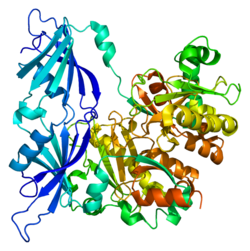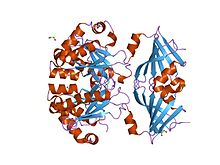In molecular biology, the five-prime cap is a specially altered nucleotide on the 5′ end of some primary transcripts such as precursor messenger RNA. This process, known as mRNA capping, is highly regulated and vital in the creation of stable and mature messenger RNA able to undergo translation during protein synthesis. Mitochondrial mRNA and chloroplastic mRNA are not capped.

Angiogenin (ANG) also known as ribonuclease 5 is a small 123 amino acid protein that in humans is encoded by the ANG gene. Angiogenin is a potent stimulator of new blood vessels through the process of angiogenesis. Ang hydrolyzes cellular RNA, resulting in modulated levels of protein synthesis and interacts with DNA causing a promoter-like increase in the expression of rRNA. Ang is associated with cancer and neurological disease through angiogenesis and through activating gene expression that suppresses apoptosis.

Guanosine monophosphate synthetase, also known as GMPS is an enzyme that converts xanthosine monophosphate to guanosine monophosphate.

Regulator of nonsense transcripts 1 is a protein that in humans is encoded by the UPF1 gene.

Trinucleotide repeat-containing gene 6A protein is a protein that in humans is encoded by the TNRC6A gene.

mRNA-decapping enzyme 2 is a protein that in humans is encoded by the DCP2 gene.

Inosine triphosphate pyrophosphatase is an enzyme that in humans is encoded by the ITPA gene, by the rdgB gene in bacteria E.coli and the HAM1 gene in yeast S. cerevisiae; the protein is also encoded by some RNA viruses of the Potyviridae family. Two transcript variants encoding two different isoforms have been found for this gene. Also, at least two other transcript variants have been identified which are probably regulatory rather than protein-coding.

Ubiquitin carboxyl-terminal hydrolase isozyme L5 is an enzyme that in humans is encoded by the UCHL5 gene.

mRNA-decapping enzyme 1A is a protein that in humans is encoded by the DCP1A gene.

DNA primase large subunit is an enzyme that in humans is encoded by the PRIM2 gene.

mRNA-capping enzyme is a protein that in humans is encoded by the RNGTT gene.

Prenylcysteine oxidase 1 is an enzyme that in humans is encoded by the PCYOX1 gene.

tRNA isopentenyltransferase, mitochondrial is an enzyme that in humans is encoded by the TRIT1 gene.

Probable cation-transporting ATPase 13A3 is an enzyme that in humans is encoded by the ATP13A3 gene.

Enhancer of mRNA-decapping protein 3 is a protein that in humans is encoded by the EDC3 gene.

NADPH-dependent diflavin oxidoreductase 1 is an enzyme that in humans is encoded by the NDOR1 gene.

Probable tRNA(His) guanylyltransferase is an enzyme that in humans is encoded by the THG1L gene.

The mRNA decapping complex is a protein complex in eukaryotic cells responsible for removal of the 5' cap. The active enzyme of the decapping complex is the bilobed Nudix family enzyme Dcp2, which hydrolyzes 5' cap and releases 7mGDP and a 5'-monophosphorylated mRNA. This decapped mRNA is inhibited for translation and will be degraded by exonucleases. The core decapping complex is conserved in eukaryotes. Dcp2 is activated by Decapping Protein 1 (Dcp1) and in higher eukaryotes joined by the scaffold protein VCS. Together with many other accessory proteins, the decapping complex assembles in P-bodies in the cytoplasm.
M7GpppX diphosphatase (EC 3.6.1.59, DcpS, m7GpppX pyrophosphatase, m7GpppN m7GMP phosphohydrolase) is an enzyme with systematic name m7G5'ppp5'N m7GMP phosphohydrolase. This enzyme catalyses the following chemical reaction
M7GpppN-mRNA hydrolase (EC 3.6.1.62, DCP2, NUDT16, D10 protein, D9 protein, D10 decapping enzyme, decapping enzyme) is an enzyme with systematic name m7GpppN-mRNA m7GDP phosphohydrolase. This enzyme catalyses the following chemical reaction
























